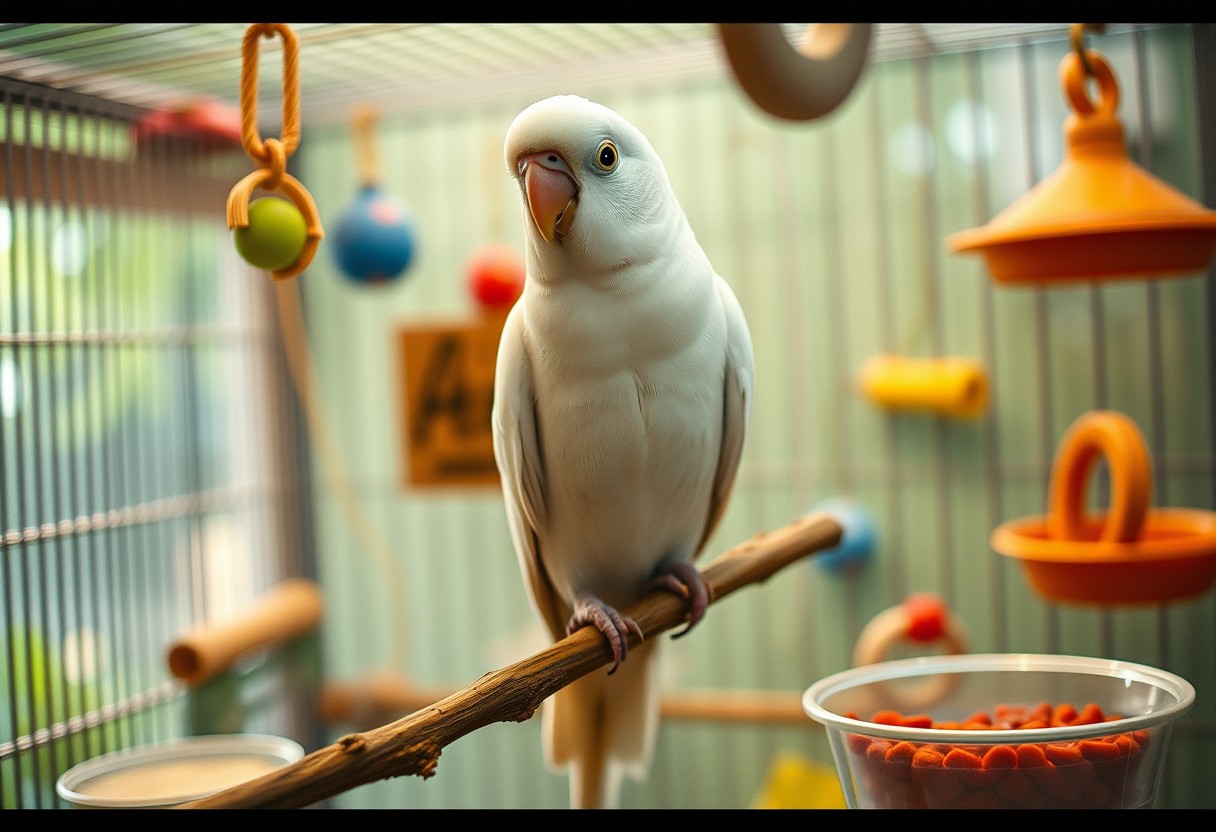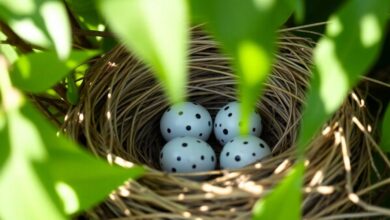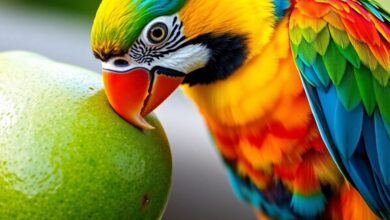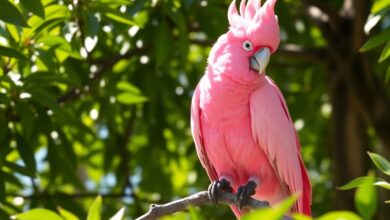
It’s crucial to understand that the White Ringneck Parakeet is a vibrant and intelligent bird that requires specific care to thrive in your home. Your new feathered friend will benefit from a balanced diet, social interaction, and a spacious environment. Ensure you provide mental stimulation through toys and activities to prevent boredom, which can lead to unwanted behaviors. By following these care instructions, you can create a nurturing environment that promotes your parakeet’s health and happiness, establishing a strong bond with your pet.

Key Takeaways:
- Diet: Ensure a balanced diet with a mix of pellets, seeds, fresh fruits, and vegetables for proper nutrition.
- Environment: Provide a spacious and stimulating habitat, equipped with perches, toys, and safe areas for exercise to promote physical and mental well-being.
- Social Interaction: Engage regularly with your parakeet, as they are social creatures that thrive on companionship and interaction with their owners.
Physical Characteristics
The White Ringneck Parakeet is a stunning bird known for its graceful physique and vibrant personality. These parrots have a long tail, a strong beak, and a sleek body, contributing to their overall charm. Their appearance changes between the age of juveniles and adults, with adults showcasing a distinct white plumage complemented by a black or dark gray neck ring, which makes them easy to identify. Understanding their physical characteristics is vital for providing them with appropriate care and an optimal living environment.
Size and Weight
Weight typically falls between 100 to 140 grams, and they grow to an average length of 16 to 18 inches from beak to tail. Individual size and weight may vary based on factors such as genetics and diet. Larger or heavier birds may require more spacious cages and additional playtime for exercise, whereas smaller individuals may thrive in more compact spaces. Adjusting their care approach based on their size can contribute significantly to their well-being.
Coloration and Markings
At maturity, the White Ringneck Parakeet displays a striking pure white plumage, often with faint yellow or gray undertones. The prominent black neck ring is a definitive feature in males, while females lack this marking, making it necessary for correct sex identification. These distinctive traits not only make them visually appealing but also indicate their health status. Ensuring a balanced diet high in vitamins and minerals can help maintain this vivid coloration; a lack of proper nutrition can lead to dullness, which may signal health issues.
This bird’s white coloration serves as a visual indicator of its health, requiring you to provide ample sunlight for optimal feather vibrancy. Additionally, you should be mindful of the potential for staining due to their diet, which can affect their appearance. Regularly grooming and maintaining its environment will help preserve its stunning look. By understanding the importance of these markings, you can ensure your White Ringneck Parakeet remains healthy and visually captivating.

Habitat Requirements
There’s a need to create a comfortable and stimulating habitat for your White Ringneck Parakeet to thrive. Providing the right living environment not only caters to their physical needs but also supports their mental well-being, allowing them to exhibit natural behaviors and maintain good health.
Cage Setup
Below, consider a cage that measures at least 24 inches wide, 24 inches deep, and 36 inches high, providing your White Ringneck Parakeet ample space to move around. Ideal materials include powder-coated metal for durability and safety. Ensure the cage features horizontal bars for climbing, along with multiple perches and toys to encourage play and exploration.
Environmental Conditions
The temperatures for your White Ringneck Parakeet should range between 65°F and 80°F, with humidity levels ideally around 40-60%. Adequate natural or artificial light is vital for their well-being—expose them to 10-12 hours of light daily, avoiding direct sunlight that may lead to overheating.
Cage placement should also be considered, ideally away from drafts and direct sunlight, providing a stable environment. Ensure your parakeet’s living space remains clean and free from toxic substances. Additionally, avoid exposing your bird to smoke, strong odors, or air pollution, as these can significantly impact their health. By maintaining the right temperature, humidity, and lighting, you can create a thriving habitat that nurtures your feathered companion’s happiness and longevity.
Diet and Nutrition
Now, as a responsible pet owner, you must provide your White Ringneck Parakeet with a balanced diet to keep it vibrant and healthy. A well-rounded diet includes a mix of high-quality seeds, formulated pellets, and plenty of fresh fruits and vegetables, which offer crucial vitamins and minerals necessary for their well-being.
Basic Diet
Below, the crucial components of a balanced diet for White Ringneck Parakeets consist primarily of seeds, which should be offered in moderation, pellets designed for parakeets as the mainstay, and a variety of fresh fruits and vegetables. Aim to provide at least 30% fresh produce to enhance their nutritional intake and ensure they receive crucial nutrients.
Supplements and Treats
Beside the basic diet, incorporating dietary supplements and occasional treats can greatly benefit your parakeet’s health. Choose supplements that are specifically made for birds, and limit treats to ensure they do not contribute to obesity. Healthy choices like small pieces of nuts or seeds can serve as excellent rewards.
Diet plays a significant role in your White Ringneck Parakeet’s overall health. While offering supplements can enhance nutritional value, avoid anything overly fatty or sugary to prevent obesity. Treats should always be healthy and in moderation, focusing on items that provide positive health benefits, such as unsweetened dry fruits or seeds, rather than processed snacks. Your careful attention to their diet will ensure a happy and long life.
Socialization and Interaction
All White Ringneck Parakeets thrive on socialization and interaction. Engaging with your parakeet not only strengthens your bond but also helps them develop a well-rounded personality. Spend time each day talking, playing, and offering treats to encourage trust and affection. Regular interaction fosters emotional well-being, making your bird feel secure and happy in its environment.
Importance of Socialization
Around White Ringneck Parakeets, social interaction is vital for their mental and emotional health. These intelligent birds benefit greatly from bonding activities like chatting and engaging games. Understanding their behavior through socialization helps you recognize cues and provides a fulfilling relationship where your parakeet feels safe and loved.
Training Techniques
At home, effective training techniques can help your White Ringneck Parakeet develop positive behaviors and maintain mental stimulation. Start with simple commands like “step up” to encourage physical interaction. Trick training can also be a rewarding way to challenge your bird while reinforcing your bond. Consistency and patience are key to successful training, so be sure to practice regularly.
With a variety of training methods, you can keep your White Ringneck Parakeet engaged and socially adept. Incorporate step-up commands to teach your bird to move onto your finger, which helps in handling and fosters trust. Trick training, such as teaching them to spin or fetch, not only provides mental stimulation but also reinforces your bond through shared achievements. Always use positive reinforcement with treats and praise, as this approach creates a safe learning environment. Avoid harsh commands, as they can lead to fear and anxiety, undermining your relationship with your pet.
Health and Wellness
Unlike some other pet birds, White Ringneck Parakeets require specific attention to their health and wellness needs. Regular monitoring of their diet, environment, and behavior can help you spot any changes that might indicate health issues. Providing a balanced diet, opportunities for mental stimulation, and a safe living space will go a long way in ensuring that your parakeet thrives.
Common Health Issues
On occasion, White Ringneck Parakeets may face health issues such as psittacosis, indicated by sneezing or nasal discharge, and feather plucking, which may suggest stress or boredom. Also, obesity, visible through weight gain, can lead to severe complications. To prevent these problems, ensure a balanced diet, plenty of physical activity, and a stimulating environment.
Routine Veterinary Care
Around the lifespan of your White Ringneck Parakeet, regular veterinary check-ups are crucial. These appointments should include full health assessments and vaccinations, which help protect against common avian diseases. Monitoring your bird’s health with your vet not only aids in early detection of issues but also positively impacts their longevity and overall quality of life.
Even in routine veterinary visits, don’t underestimate the importance of being proactive about your parakeet’s health. By scheduling regular check-ups, you can catch potential issues such as respiratory infections or nutritional deficiencies before they become serious. Providing your vet with details about your bird’s behavior, diet, and environment will help formulate a better health strategy, leading to a happier and longer life for your feathered friend.

Grooming and Maintenance
Many owners may overlook the grooming needs of their White Ringneck Parakeets, but regular care is important for their overall well-being. Consistent grooming helps maintain their vibrant feathers and healthy skin. You should provide them with opportunities for bathing, which can be done in a shallow dish or misting them lightly with water, allowing them to enjoy the experience. Feather trimming can be necessary for their safety; however, always consult a professional avian groomer before attempting this to avoid any harm.
Feather Care
About feather care, your White Ringneck Parakeet will benefit from regular baths, which help keep their feathers clean and free of dust. Use a shallow bowl of lukewarm water or mist them lightly to encourage preening. While some owners may feel the need to trim feathers, it’s important to consult an avian vet to understand the right techniques and tools to use, ensuring your bird is comfortable and safe throughout the process.
Nail and Beak Care
Beak and nail care are important for the health of your White Ringneck Parakeet. You should regularly check both for overgrowth; overgrown nails can cause injury to their feet, while a long beak may hinder feeding. Providing natural wood perches and chew toys can help keep their nails trimmed naturally. If you notice any signs of overgrowth or abnormalities, seek advice from an avian veterinarian to determine whether trimming is required.
Grooming your White Ringneck Parakeet includes regularly checking its nails and beak. If you let nails grow too long, they can curl, causing pain or injury, while an overgrown beak can make feeding difficult. Providing chew toys and natural perches can aid in naturally wearing down nails and beak. You should perform regular inspections and seek professional help when necessary, ensuring your parakeet remains healthy and happy.
Conclusion
Now that you have a better understanding of how to care for your White Ringneck Parakeet, you will be well-equipped to provide a loving and healthy environment for your feathered friend. Prioritizing their diet, social interaction, and mental stimulation will enhance their well-being. For comprehensive insights into the care of the Indian Ringneck Parakeet (Rose-Ringed Parakeet), you can explore more here. Your commitment will ensure they thrive as a cherished companion.
FAQ
Q: What is the ideal diet for a White Ringneck Parakeet?
A: A well-balanced diet for a White Ringneck Parakeet should include high-quality pellets, fresh fruits, and vegetables. Seeds can be given as a treat but should not be the main food source, as they are high in fat. Offer leafy greens like spinach and kale, along with small amounts of carrots, apples, and berries. Always ensure fresh, clean water is available, and avoid giving them avocado, chocolate, or caffeine, as these can be toxic to birds.
Q: How much social interaction does a White Ringneck Parakeet need?
A: White Ringneck Parakeets are highly social creatures that thrive on interaction. They should ideally be given at least 2-3 hours of dedicated interaction with their owners each day. This can include talking, playing, or even training sessions. If possible, consider providing companionship in the form of another parakeet, but be mindful of proper introductions to avoid territorial behaviors. Regular interaction helps keep your bird mentally stimulated and emotionally happy.
Q: What are the best housing conditions for a White Ringneck Parakeet?
A: Providing a spacious and safe environment for your White Ringneck Parakeet is important. A cage that is at least 24 inches wide, 24 inches deep, and 36 inches tall is recommended to allow for adequate movement and play. Use non-toxic wood perches of varying diameters to support their foot health, and make sure the cage is equipped with toys that encourage mental stimulation. Be sure to place the cage in a well-lit area but out of direct sunlight and drafts, as both can be harmful to your bird’s well-being.




